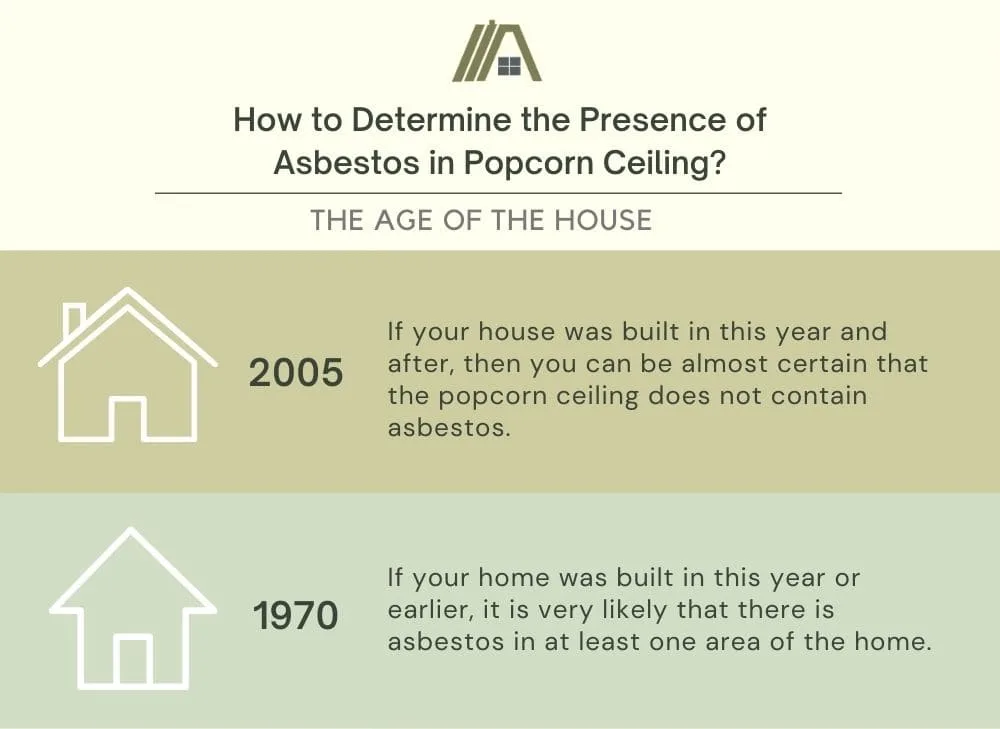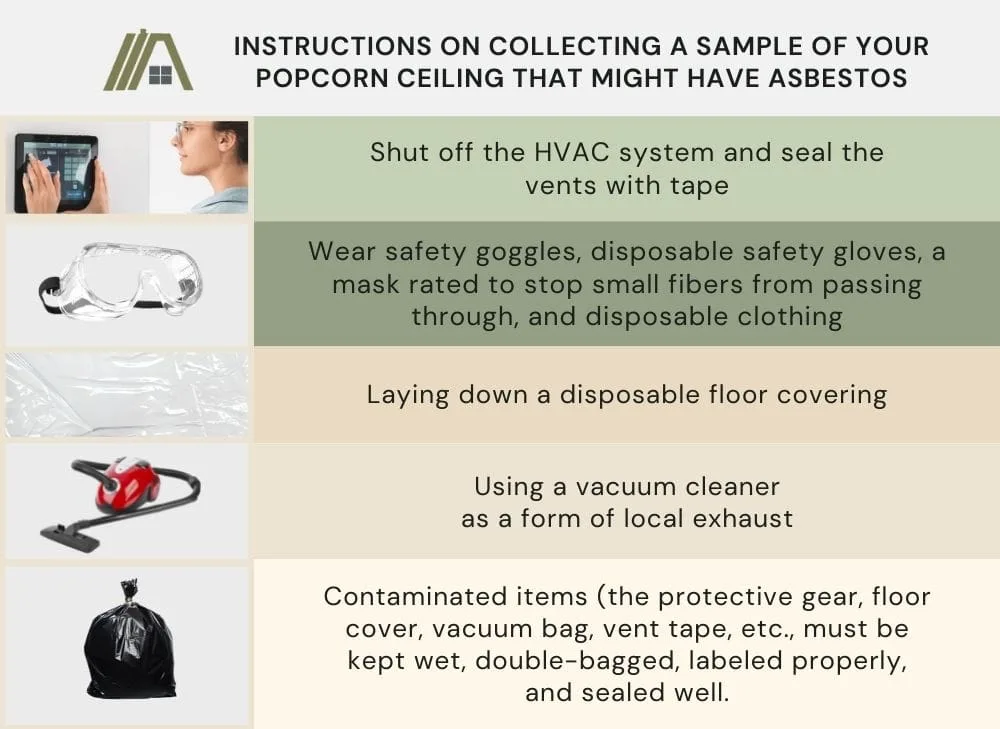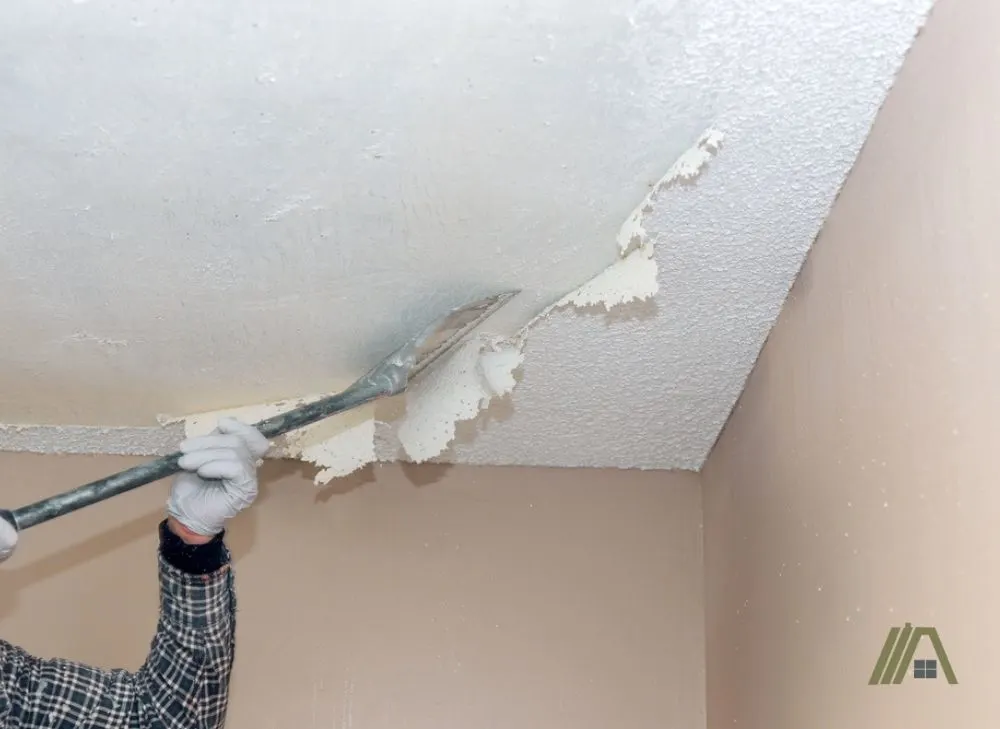An innocent internet search on popcorn ceilings unveils a scary truth—popcorn ceilings can contain asbestos! It turns out that asbestos is both very bad for your health and a very good construction material. Unfortunately, the latter was discovered a good few decades before the former, and popcorn ceiling was commonly created using asbestos-containing materials.
Even more unfortunate is the fact that differentiating between safe, non-toxic popcorn ceilings and those that contain asbestos is not something you will be able to do by yourself. However, checking your popcorn ceiling is worth the time and effort, so let’s get to it.

Visual confirmation of asbestos in popcorn ceiling is near impossible. A blue tint may suggest the presence of one type of asbestos. Symptoms of asbestos exposure arise decades after exposure, so they are unreliable indicators. The best way to tell if a ceiling has asbestos is to get a lab to test a sample.
There Are No Visual Indicators
Although it would make life much easier, the reality is that asbestos can be very hard to identify based on sight alone.
Individual fibers are only visible under a microscope. This is one of the features that make handling it so dangerous. They readily become airborne, and you cannot see them to ensure that the individual fibers are contained.
When there are groups or clumps of asbestos fibers, you are able to see them with the naked eye, but even then, they can be difficult to identify as asbestos fibers as opposed to any other fibers.
The color of asbestos fibers can range from blue to brown to white. This is because there are three main types of asbestos: crocidolite, amosite, and chrysotile asbestos.
Crocidolite asbestos is the most dangerous. Thankfully, it’s also the one that is blue, and so it is easier to identify visually. If your popcorn ceiling has a blue tinge to it, or you can see definite clumps of blue, then it’s definitely time to call in the experts.
I cannot continue before adding a word of caution. Asbestos is not something you want to be messing with. Simply scraping off a small section of the paint on your ceiling to examine if there is a blue tint to the underlying plaster could mean that previously contained asbestos fibers become airborne.
There are rules about how asbestos and even possible asbestos-containing items need to be handled, and you will not be able to meet the requirements satisfactorily with any household or hardware store-sourced product.
Physical Effects Only Manifest Years/Decades Later
Some substances that are harmful to your health and which are found in homes can be identified by the symptoms they cause soon after exposure. Examples of such substances are mold and carbon monoxide.
For mold, allergy symptoms may be observed within a few minutes of exposure. In carbon monoxide’s case, symptoms of dizziness, stomach pain, and loss of consciousness can be felt within two hours of exposure.
This quick development of symptoms can make confirming your suspicions just as rapid, although no one really wants to find out about these things in such a way.
For asbestos, though, the latency period, or the period between exposure and when you begin feeling sick, can be ten to forty years! Furthermore, once you start exhibiting signs of exposure, then it’s too late—you are looking at treatment rather than cure.
As such, symptom development is not a good indicator of asbestos being present in your popcorn ceiling.
When Was the House Built?
Here we come to a more reliable method of determining the presence of asbestos in popcorn ceiling: the age of the house.
The long latency period of asbestos meant that it took decades to link this material with adverse health effects, and it was used relatively prolifically between its discovery and the discovery of its danger to health.
So, if your house was built, or more specifically, if your popcorn ceiling was installed before asbestos was banned, then the chances are high that it contains asbestos.
Modern popcorn ceilings do not contain asbestos. The textured look of popcorn ceilings is now achieved through a mixture of calcium carbonate and polystyrene. But what is considered to be a modern home?
To be absolutely safe, I would say that if your house was built in the year 2005 and after, then you can be almost certain that the popcorn ceiling does not contain asbestos.
If your home was built in the 70s or earlier, it is very likely that there is asbestos in at least one area of the home (that’s right; it’s not just the popcorn ceilings you have to worry about!). An older home like this is at great risk of causing asbestos-related sickness in its inhabitants.

Technically, asbestos was legally phased out of homes and other various goods in 1979 in Canada, 1989 in the US, and 1999 in the UK. However, homes built in the 80s and 90s (even the early 2000s in the case of UK houses) may still contain asbestos.
It takes a while for legislation to come into effect and for something so widespread to be phased out. In addition, it takes just as long, if not longer, for people to give up a useful material just because the scientists say it’s bad for you.
Get It Tested if You Are Concerned
If your home’s construction year indicates that it may contain asbestos or you have any other reason to believe that your home’s residents are in danger of asbestos-related illnesses, it is wise to contact a testing lab as soon as possible.
It is imperative that the lab is official, permitted to do asbestos testing, and reputable.
All of these qualifications would ensure that the testing of your home (and any required action) is carried out in a manner that is as accurate, swift, and safe as possible.
The availability of accredited labs may vary by location. For example, the availability of asbestos-testing labs in America varies by state. New York has Allied Asbestos Inspectors Inc. and others, while California has Asbestos Laboratories and others.
Collecting the Sample
Offsite Sampling
The cheapest option for collecting a sample is to do it yourself (called offsite testing). The cost is then limited to the actual test, and it ranges from $50 to $80. Results can be expected in one to two weeks unless you pay for a rush test, in which case you can have your results within 24 hours.
The sample can be a small portion of a ceiling tile, some clumps of the “popcorn” of the popcorn ceiling, or dust collected from the ceiling (not regular dust as in dirt but rather dust from the ceiling materials itself). Dust sample testing is more expensive, however, at around $120 to $180.
If the lab you have chosen asks you to collect the sample, make sure that they provide you with detailed instructions on how to do this and how to be safe while doing it. Remember, any disturbance to the ceiling, like scraping or cutting a piece off, can release fibers into the air.
Typical instructions should include:
- Shut off the HVAC system and seal the vents with tape. This will prevent any asbestos fibers (should they be present) from spreading throughout your home.
- Wear safety goggles (preferably ones that suction onto your face), disposable safety gloves, a mask rated to stop small fibers from passing through, and disposable clothing.
- Laying down a disposable floor covering.
- Using a vacuum cleaner as a form of local exhaust. You would hold the vacuum hose right by the area you are working in so that it can suck up any stray fibers.
- Contaminated items (the protective gear, floor cover, vacuum bag, vent tape, etc., must be kept wet, double-bagged, labeled properly, and sealed well. The bags must then be dropped off at a designated landfill that accepts asbestos. This disposal process is mandated by law.

Onsite Sampling
Even if the lab offers you instructions on how to collect your own asbestos sample, I personally would not recommend offsite testing.
I studied occupational hygiene and the what I learned about asbestos (the hazards and how it has to be handled) have given me a healthy respect for these tiny fibers, and I’d rather leave it all to the professionals.
Onsite testing is more expensive but the process is streamlined, done by professionals, and is much safer for the residents.
While the price of onsite testing can greatly depend on your location and what can be gathered as samples, it can cost between $250 and $750.
What Happens if Asbestos Is Found?
If asbestos is found, asbestos repair or removal must be done.
Asbestos Repair
Asbestos repair is usually favored and it involves preventing the fibers from becoming airborne by either encapsulation with a coating of sealant or by enclosure by covering the asbestos with an airtight material.
This process is favored because it is a simpler process and involves much less risk. The asbestos is prevented from spreading and enclosed rather than removed.
Of course it means that you will not be able to install a nice ceiling fan, re-do the surface to get rid of the popcorn effect, or do anything that would compromise the encapsulation. However, there are ways to cover popcorn ceiling without removing it if you are looking for a different aesthetic.
Asbestos Removal
Asbestos removal is fairly self-explanatory. Efforts are made to remove all traces of asbestos from the home. Unfortunately, the removal process can cause asbestos to become airborne and move throughout the home. Because asbestos is so small, escaping particles would be very difficult to see.

For this reason, it is highly recommended that asbestos repair rather than removal be done in a home with asbestos.
Hire Professionals
Either of these processes must be done by professionals in various protective gear items, including suits and masks. The area is also sealed off and HEPA filters are used to protect the rest of the home.
Cleanup is also done by these professionals as well as a post-removal/repair assessment that ensures that the removal or repair was successful.
Although DIY removal is not strictly disallowed, it is absolutely not recommended. Professionals are trained and have the knowledge and gear to deal with these situations.
An untrained homeowner can put themself and those around them in danger if they go through with a removal or repair project themselves.
Sources
https://www.bobvila.com/articles/what-does-asbestos-look-like/
https://www.asbestos123.com/news/asbestos-testing-process-costs-testing-companies/

